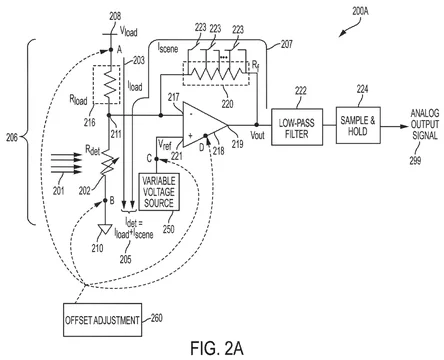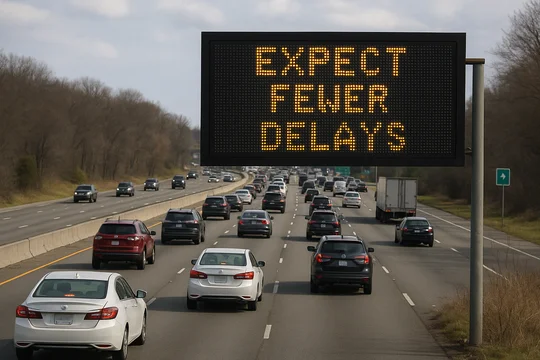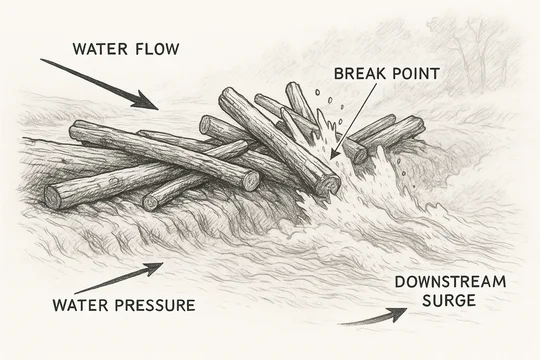
This is an issue I don't recall having seen before. In VTT Technical Research Centre of Finland Ltd. v. Teledyne Flir, LLC, C.A. No. 25-348 (D. Del.), the plaintiff filed a pretty typical-looking patent complaint, where it alleged infringement of its patent by the defendant's products.
The complaint, however, relied on an allegation that the product was marked as practicing a particular patent, and that figure 2A of that patent showed a circuit that infringed on the plaintiff's patent:
According to VTT, the figure (“Figure 2A”) [of the defendant's own patent] depicts the allegedly infringing functionality. . . . In the complaint, VTT alleges on information and belief that the Boson and Boson+ products incorporate the functionality disclosed in Figure 2A, based in part on the fact that [defendant] Teledyne virtually marks the Boson product with the ’647 patent and the fact that the Boson+ product is a later iteration of the Boson product.
VTT Technical Research Centre of Finland Ltd. v. Teledyne Flir, LLC, C.A. No. 25-348, at 2 (D. Del. Sept. 5, 2025).
The defendant moved to dismiss, arguing that the plaintiff cannot base its allegation of infringement on an allegation that the accused products practice their own patent, and that the system shown in that patent infringes:
Teledyne . . . argues that VTT has failed to meet that standard because VTT bases its infringement allegations on Figure 2A of the ’647 patent rather than basing its allegations on an analysis of the accused products. . . . The flaw in VTT’s approach, Teledyne argues, is that VTT has not established a sufficient factual basis for its assertion that the Boson and Boson+ products practice Figure 2A of the ’647 patent.
Id. at 3.
That's an interesting argument. Presumably the defendant's patent has claims may not track exactly what is in that patent's specification, and I would imagine it is marked as long as it practices the claims, not necessarily each figure of the specification.
But there was more here, too. Plaintiff responded that it had sent a notice letter to the defendant, and that the defendant had not disputed that its products practice Figure 2A of the defendant's patents:
VTT responds that it is plausible to infer that the Boson and Boson+ products practice Figure 2A because the Boson product is virtually marked with the ’647 patent, in which Figure 2A is found. . . . VTT also explains that it identified Figure 2A as support for its infringement allegations in its notice letter to Teledyne, yet Teledyne never disputed that its products practice Figure 2A.
Id. at 4.
The Court agreed with plaintiff that the simple fact of marking the product with a patent that practices the claims is enough:
I agree that given the patent marking allegation, it is plausible to infer that the Boson product practices the ’647 patent, and in particular Figure 2A of that patent, which purports to depict circuitry used in the claimed invention of that patent. And given the allegation that the Boson+ product is an iteration of the Boson product, it is plausible to infer that the Boson+ product also practices the embodiment depicted in Figure 2A. Although Teledyne may end up being correct that the Boson and Boson+ products do not practice Figure 2A, reaching that conclusion now would require drawing inferences against VTT. Because at the motion-to-dismiss stage all inferences must be drawn in favor of the non-moving party, . . . I conclude that VTT’s reliance on the disclosures in Figure 2A as factual support for its infringement theory is sufficient to support its direct infringement claim.
Id. at 4.
It looks like the Court did not focus on the notice letter for this point, and it may be that this case will stand for the simple proposition that marking a product with a patent which has embodiments that practice a second patent is sufficient to support an allegation of infringement as to the second patent.
The Court additionally permitted an inference that the later iteration of the marked product also infringes.
It rejected an argument that the plaintiff needed to buy a product an analyze it rather than relying on the fact that it was marked with patent containing an infringing embodiment, particularly in light of the correspondence alleging infringement based on marking:
I disagree with Teledyne’s argument that VTT should have acquired an accused product and analyzed the product itself in the complaint. Dkt. No. 25 at 3. Although analyzing he accused product is often a preferable approach, “patentees need not prove their case at the pleading stage.” . . . Requiring VTT to acquire and analyze the product would improperly impose a heightened standard on VTT, especially given Teledyne’s virtual marking and the correspondence that occurred between the two parties after VTT sent its notice letter but before VTT filed this lawsuit. To be sure, there may be instances in which acquiring and analyzing the accused product is necessary to state a claim of infringement, but in light of the other allegations relating to infringement, this is not one of those instances.
Id. at 4-5. The Court also rejected an argument that the list of accused products was inadequate because they relied on the allegations about the patent figure, for the same reasons. Id. at 6.
No Early SJ On Anticipation, Either
In the alternative, the defendant pointed out that the asserted patent cited, as prior art, a patent the contains identical components to the Figure 2A that it relies on to show infringement.
In other words, it is accusing products of infringement that are, at least for the purposes of the complaint, identical to prior art cited in the patent. It asked the Court to take judicial notice of some PTO records supporting this invalidity argument.
The Court did not bite:
Teledyne argues that if Figure 2A infringes the ’369 patent, the prior art figure would anticipate VTT’s ’369 patent. . . . VTT responds that Teledyne’s argument raises claim construction issues and factual disputes that are not ripe for resolution at this stage of the litigation. . . . I agree with VTT. Teledyne’s argument requires that I conclude that Figure 2A has “material components” that are identical to those of the figure in the prior art reference; reaching that conclusion would require me to make factual determinations that I cannot make at this juncture. . . . Teledyne has not argued that VTT’s pleading is vague or ambiguous. Instead, Teledyne has asserted that VTT’s infringement theory, if viable, will necessarily lead to invalidity problems for VTT. If Teledyne’s argument has force, it can be developed through discovery and pretrial motions. It is not an appropriate subject for a motion to dismiss the complaint. Accordingly, I reject this argument and will deny Teledyne’s request that I take judicial notice of the Patent and Trademark Office records that Teledyne asserts would support its theory.
Id. at 5-6.
If you enjoyed this post, consider subscribing to receive free e-mail updates about new posts.





